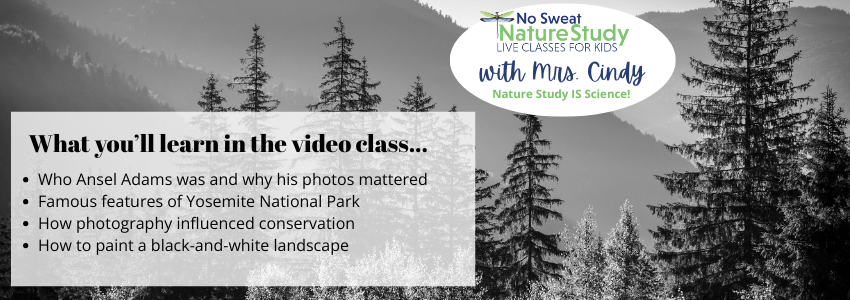How Did a Camera Help People See Nature?
An Ansel Adams nature study introduces children to the art of observing nature through the lens of a camera. In this podcast episode, young learners meet the photographer who became known for capturing the beauty of wild places in black and white, helping others notice details they may have never seen before.
Instead of studying animals or plants this time, children will be encouraged to slow down and observe landscapes carefully. Just like a nature-loving artist with a camera in hand, they’ll begin to notice shapes, patterns, and beauty they may have missed before.
Ansel Adams Podcast Discussion Questions
After listening to the episode together, use these questions to check your child’s understanding and spark a thoughtful nature-focused conversation.
- Who was Ansel Adams, and what was he known for? (He was a photographer known for taking black-and-white pictures of nature, especially Yosemite.)
- What kinds of natural scenes did Ansel Adams like to photograph? (Mountains, waterfalls, trees, cliffs – especially places in Yosemite National Park.)
- Why did people start noticing nature more after seeing his photos? (Because his pictures made nature look extra beautiful, helping people appreciate and care about wild places.)
- What’s something you think Ansel Adams had to do before taking a great picture? (Observe carefully, look for interesting shapes, notice the light, and take his time.)
- Why do you think he chose black-and-white instead of color? (Answers may vary, but kids might say it helped show shadows, light, and textures better, or that’s what cameras used back then.)
- Do you think photography is a good way to study nature? Why or why not? (Open discussion – encourage them to reflect on how observation plays a role.)
- If you could take a black-and-white picture of something in nature today, what would it be? (There are no wrong answers!)
- How could you use a camera to notice something new outside today? (This is a practical encouragement to go observe and “see like Ansel Adams.”)
Ansel Adams Nature Study Video Class
The podcast offers a small introduction to how a camera can help us notice nature in new ways. Inside the corresponding video class, students learn more about Ansel Adams’ life and explore the iconic Yosemite landscapes he loved to photograph.
They observe waterfalls, granite cliffs, and giant trees before creating a black-and-white value painting using techniques inspired by Adams’ photography. It’s a meaningful blend of science, history, and art that builds thoughtful observation skills through nature study.

Our List of Nature-Themed Books
The No Sweat Nature Study Podcast community has been sharing recommendations of excellent nature-themed books. Click here to find a compilation of listener favorites!
Would you like to record a voicemail to answer this season’s nature study question?
At the end of each No Sweat Nature Study Podcast episode, Mrs. Cindy includes messages from a few of her friends. You can record a message that she might use on an upcoming episode!
All children must have their parents’ permission before leaving a recording. Parents are welcome to record an answer, too!
Each season, there will be a different question to answer. You can see this season’s question below. Think about your answer first, and then follow these simple directions:
- Click the “Start recording” button.
- Tell me your first name. (If you want to tell your age and/or where you live, feel free to do that.)
- You will have 60 seconds to answer the question, but try to be concise.
- Push the play button to listen to your recording before sending it, to ensure it is recorded correctly. If not, record it again.
Please leave a rating or a review on your podcast app! It helps the podcast to show up for more people…which means more families can enjoy science through the wonderful lens of nature study! Thank you!

I love your podcast and video class Ms. Cindy!
Ms. Cindy is the best! Wow!
That’s so nice! Thank you!
Yay! Thank you for leaving such a kind comment!